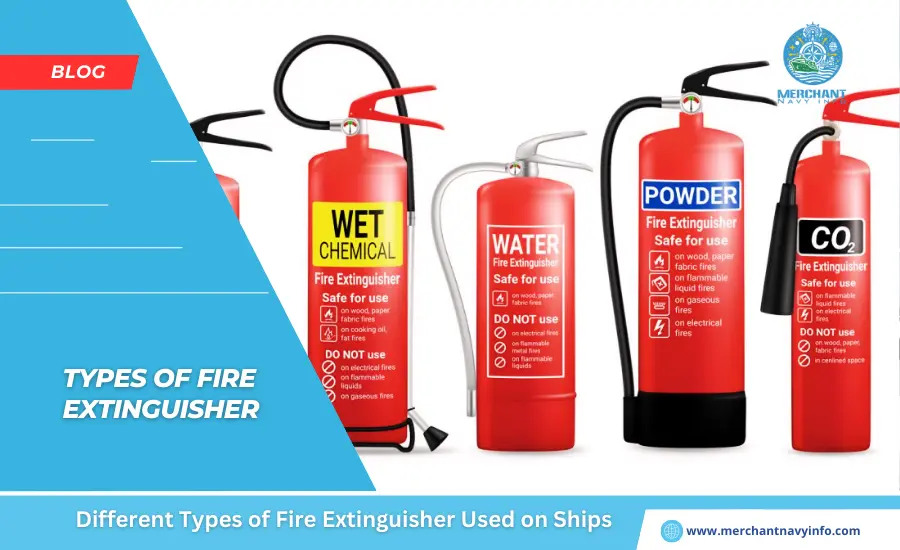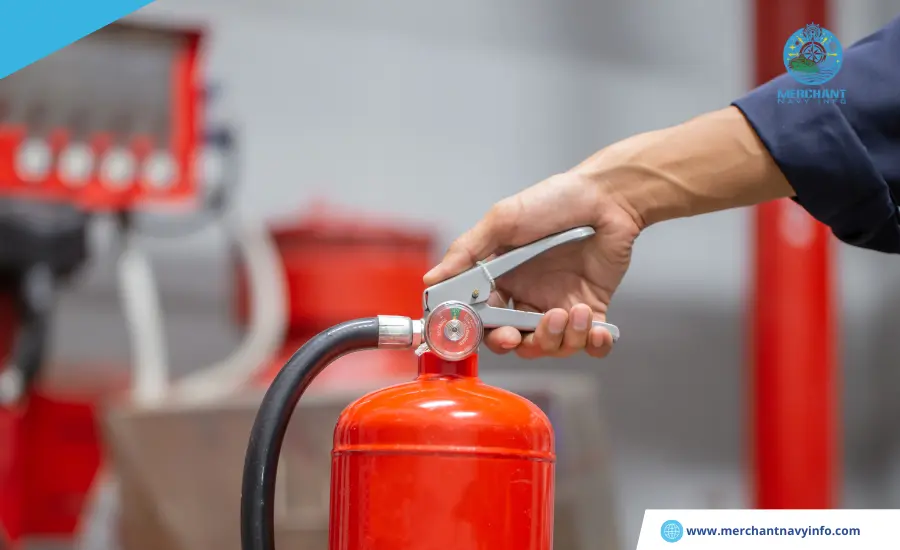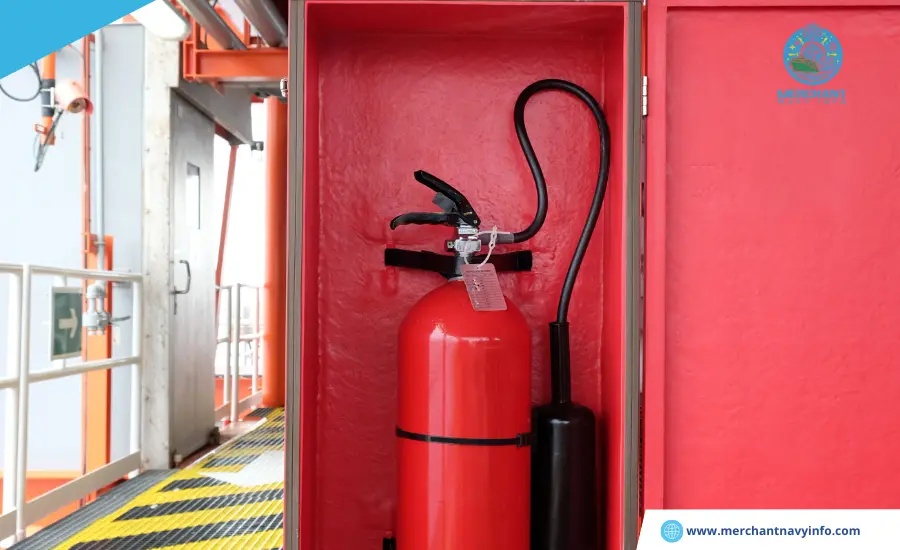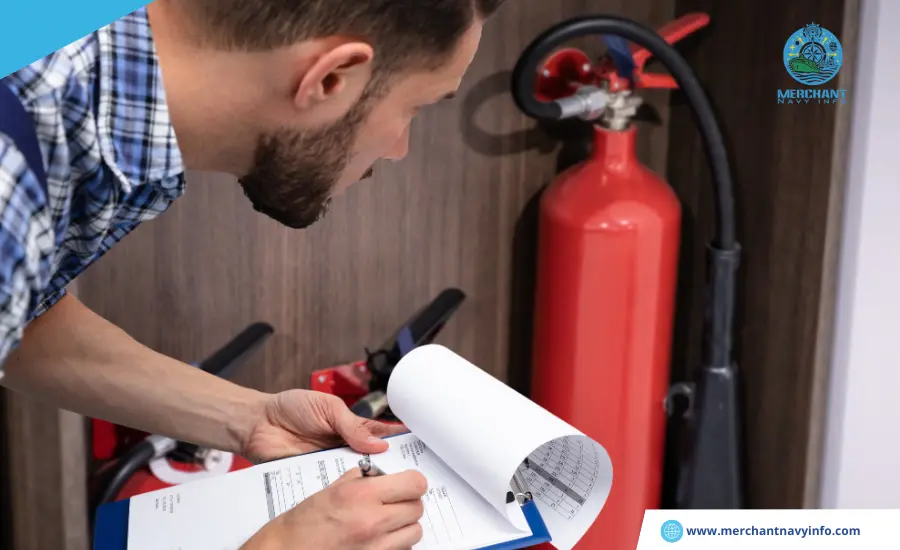
The types of fire extinguisher in ship depends on the type of fire on board and the substance used as fuel. As fires are classified based on the type of fuel they are fired by, so are the extinguishers. Ships fire extinguishing systems and types of extinguishers can be classified into three categories:
- Portable extinguishers
- Semi-portable extinguishers
- Fixed Fire Extinguishing Systems on Ships
This article lists and also describes the different types of SOLAS-approved fire extinguishers (portable and semi-portable) on ships that are installed in different locations on board, depending on the type of fire.
There Are Mainly Five Classes Of Portable Marine Fire Extinguishers:

Class A:
These types of extinguishers are used for fires caused by Burning wood, fiberglass, upholstered furniture, and furnishings. Water extinguishers, DCP extinguishers, and foam extinguishers usually extinguish Class A fires by eliminating the heating element of the fire triangle. The foaming agent also helps to separate the oxygen component from the other components.
Class B:
These extinguishers are used for fires caused by liquids such as lubricants, fuels, paints, and edible oils. This Class allows the use of portable CO2 or portable DCP extinguishers.
Class C:
Fires caused by energized electrical equipment such as motors, switches, and cables are extinguished using Class C extinguishers. Typically, portable CO2 or DCP extinguishers are used for such fires.
Class D:
Fires caused by combustible materials such as magnesium and aluminum are extinguished with this type of extinguisher. These elements burn at high temperatures and react violently when in contact with water, air, carbon dioxide, and other chemicals.
Class E:
This type of extinguisher is used on ships to extinguish fires caused by the above substances or by high voltage. Therefore, using a portable extinguisher with conductive agent to extinguish a class E fire may pose a small risk of electric shock to the user. For such fires portable CO2 or DCP extinguishers are used.
Types Of Portable Extinguishers Used On Ships:

When selecting a fire extinguisher for a ship, it is necessary to take into account the extinguisher’s response to different types of flammable substances and liquids in different parts of the ship and to the source of fire. Portable extinguishers are divided into five classes based on the above classification and are used according to IMO. Portable shipboard fire extinguishers used on ships and at sea are also known as piston extinguishers, as they use a piston mechanism to release the overall extinguishing agent.
There Are Five Main Types of Fire Extinguisher in Ship Used On the Ships:
- Soda Acid Extinguisher
- Water Extinguisher
- Foam Extinguisher – Chemical and Mechanical Extinguisher
- 4. Carbon Dioxide Fire Extinguisher
- Powder Fire Extinguisher
Types of Fire Extinguisher in Ship

1. Soda Acid Extinguishers
Soda Acid extinguishers are recommended for extinguishing Class A fires. Acid extinguishers are installed in the ship’s accommodation areas. Sodium bicarbonate (soda) and sulfuric acid are the main ingredients in the extinguisher. When they combine, they undergo a chemical reaction that produces carbon dioxide gas, which is used to extinguish the fire. A fire extinguisher consists of a container containing a sodium bicarbonate solution. A small glass bottle (vial) containing sulphuric acid is placed under a piston mechanism which is covered at the top with safety glass and a screw and cap. When the piston is struck hard, the glass bottle breaks, and the acid and soda mix. A chemical reaction occurs, also which produces carbon dioxide gas.
2. Water Extinguisher
Portable 9-litre water extinguishers are used to extinguish Class A fires. The outer container is filled with water and is fitted with a CO2 cartridge (inner container) that uses pressure to push the water out of the container. To activate the extinguisher, first remove the safety pin/clip. When pressure is applied to the piston, the CO2 cartridge bursts, forcing the water out of the extinguisher.
3. Foam Extinguishers
Chemical and also Mechanical Foam extinguishers are used to extinguish Class B fires and are placed near flammable liquids. There are two types of foam extinguishers depending on their contents:
- Chemical Foam Extinguisher
- Mechanical Foam Extinguisher Chemical Foam Extinguisher
The chemicals used in this foam extinguisher are sodium bicarbonate and also aluminum sulfate. The main container is filled with the sodium bicarbonate, and also the inner container is filled with aluminum sulfate. Rotate the plunger to loosen the cap and turn the extinguisher upside down to mix the two chemicals. The chemical reaction produces carbon dioxide, which creates pressure inside the container and also pushes the foam out. The chemical formula for this type of portable foam extinguisher is given below:
Al2 (SO4)3 + 6 NaHCO3 -> 2Al (OH) 3 + 3Na2SO4 + 6 Co2
Mechanical Foam Extinguisher
This type of extinguisher also consists of the following components:
Two containers – the outer container contains water, and also the middle container contains a charge of carbon dioxide and also a foaming solution. Mechanical foam extinguishers use a long hose connected to a dip tube within the structure of the extinguisher, allowing portable foam extinguishers to be used upright.
4. Carbon Dioxide Fire Extinguishers
Carbon Dioxide fire extinguishers are also primarily used for class B or C fires. They cannot be used in residential areas or enclosed spaces as the gas used is lethal. They are often used as engine room fire extinguishers. Carbon dioxide is stored in the liquid form under pressure. The central pipe acts as the carbon dioxide outlet. A piston connected at one end to a bursting disc and at the other end to a trigger is used to release the carbon dioxide gas. The liquid turns into the gas as it leaves the extinguisher through the hose.
5. Dry Chemical Extinguishers
Sodium bicarbonate powder is mostly used to extinguish almost all types of fires. They are primarily found in engine compartments and also near electrical equipment. Dry chemical extinguishers have an outer container that contains sodium bicarbonate powder. Under the piston mechanism is a small container of carbon dioxide. When the piston is pressed, carbon dioxide gas is released, forcing the dry powder out of the outlet nozzle.
Semi-Portable Extinguishers:
Semi-portable extinguishers have a larger capacity and also weight than portable extinguishers. These are considered a second line of defense in case the portable extinguishers fail to stop the fire. As they are heavy to lift, they are equipped with a trolley device that can be used to tow them to the nearest fire scene. They can be either semi-portable foam extinguishers or semi-portable DCP-type extinguishers. These extinguishers are kept in areas of the ship where there is a high risk of fire. For example, semi-portable extinguishers are located near the boilers and incinerators in the engine room and also in the galleys. In addition to portable extinguishers, a ship’s galley fire extinguishing system may also include a small permanent CO2 extinguishing system.
How To Use A Portable Fire Extinguisher:

The following diagram shows how a portable fire extinguisher works: Maintaining portable fire extinguishers on your ship:
- Portable fire extinguishers are pressure vessels and alsomust be inspected regularly for leaks, etc.
- The operating mechanism of a portable fire extinguisher should be checked every three months (if possible).
- Vents should be checked for any play.
- All cap threads should be lightly greased. The screw cap has holes to release excess pressure. Make sure these holes are open.
- Check if the piston moves freely and also replace any missing or damaged pistons.
Other Portable Fire Extinguishing Systems:
Marine portable foam applicators: This type of portable fire extinguishing unit consists of a portable foam tank with at least 20 liters of foam-forming liquid and a foam applicator connected to a type of induction device. A nozzle and extinguishing line are connected via a hose. A spare tank with a foaming agent is also available. To extinguish an oil fire, the nozzle must be capable of producing at least 1.5 m3/m3 of foam.
CTC Extinguisher:
CTC extinguishers were very effective in extinguishing small fires. However, they are no longer used on ships due to their tendency to emit harmful toxic phosgene gas. The official name of the CTC extinguisher is Carbon Tetrachloride Extinguisher.









